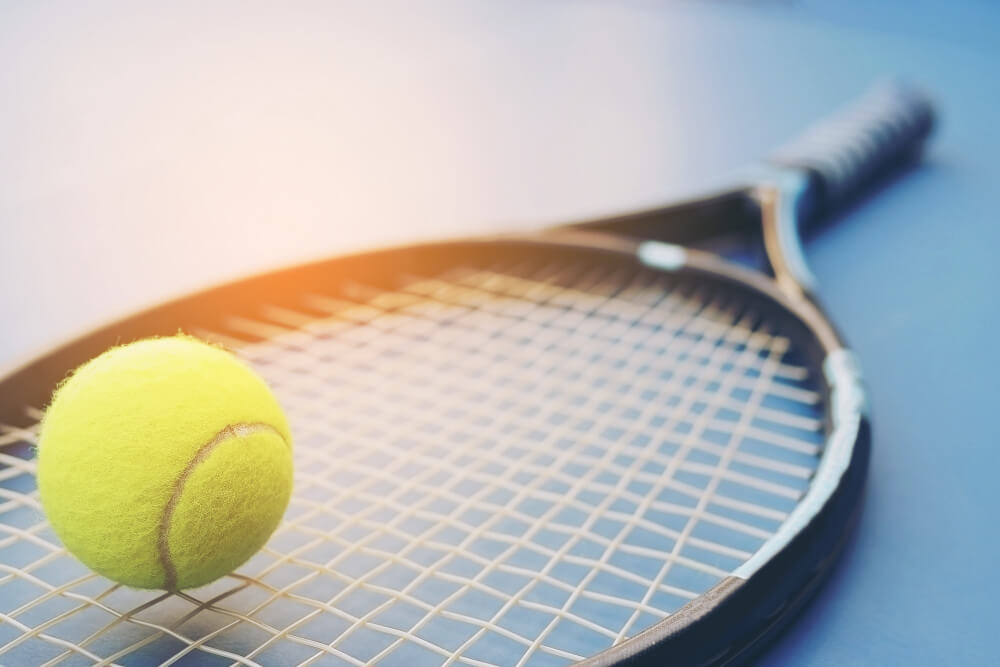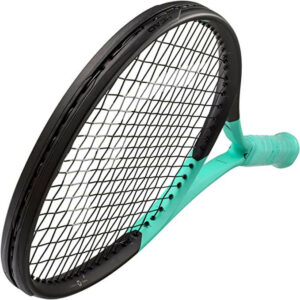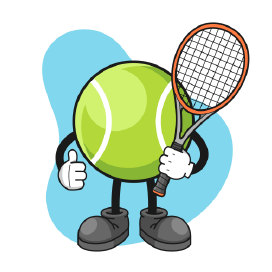The best tennis string pattern depends on a player’s playing style and preferences. Different string patterns offer various levels of control, spin, power, and durability. In general, the tighter the pattern with fewer gaps between strings, the more control it offers while sacrificing some spin potential and power.
On the other hand, a looser pattern with larger gaps provides more spin but less control. Additionally, thinner strings create more power and spin because they are easier to deform when hit, however, they tend to break more quickly than thicker strings. Ultimately, it is important for players to experiment with different string patterns until they find something that suits their individual needs and preferences.
What Is The Different Types Of Tennis String Patterns?
The three most popular types of string patterns are:
-
- Open (16×19 or 16×18)
- Hybrid (18×20 or 17×19)
- Closed (16×20 or 18×20).
Generally, open patterns are best for big hitters who want more spin potential; hybrid patterns are favored by medium-level players looking to find the perfect balance between power and control; while closed patterns offer more control and less spin. Each of these generalizations can vary depending on other factors such as string gauge, tension, material, etc.
Ultimately, finding the optimal tennis string pattern for a player’s game is about trial and error. It may take some time before one finds the perfect combination that works well with their playing style and preferences. However, once a player identifies what works best for them it will help to further their development as a tennis players.
Does String Pattern Matter In Tennis?
Yes, string pattern can have an impact on a player’s performance as it affects the amount of control, spin, and power they will have. It is important to experiment with different patterns until you find the one that best suits your individual needs and preferences. With this knowledge, you can take your game to the next level.
What Difference Does A String Pattern Make?
The pattern of the strings on a tennis racket can influence the level of control, spin, and power a player can generate. Generally, open patterns offer more spin potential; hybrid patterns find the perfect balance between power and control; while closed patterns provide more control and less spin. Additionally, string gauge, tension, and material can also contribute to how each string pattern performs. This is why it is essential for players to experiment with different combinations until they find one that works best for them.
If You Could Only Choose One Tennis String Pattern Which Should It Be?
There is no single ideal tennis string pattern as each individual’s playing style and preferences are unique. Therefore, it is important to experiment with different strings until you find what works best for your game.
A great starting point might be a hybrid string pattern as it offers a good balance between power, control, and spin potential. If this does not suit your needs, you can try open or closed patterns until you find something that fits your game.
At the end of the day, finding the best tennis string pattern is all about trial and error. It may take some time before one finds the perfect combination that works well with their playing style and preferences.
What Is The Difference Between 16×19 And 18×20 String Patterns?
- 16×19 is an open string pattern, which has fewer gaps between the strings. It offers more spin potential but less control than a closed string pattern (18×20).
- On the other hand, 18×20 is a closed string pattern that has tighter spacing between the strings. This provides better control while sacrificing some spin potential and power.
Ultimately, it depends on each individual’s playing style and preferences as to which one they prefer. Additionally, the material of the strings can also have an effect on how well they perform within each pattern. As such, experimenting with different combinations until you find what works best for your game is essential.
What Type Of String Do Most Pros Use?
Many professional players opt for a hybrid string pattern, as it provides a good balance between power, control, and spin capabilities.
Additionally, many pros also experiment with different strings to find what works best for them. Therefore, depending on their individual preferences, some may opt for open or closed patterns over hybrids. Ultimately, it is important for each player to identify what works well with their playing style and preferences in order to take their game to the next level.

What Is The Best Tennis String For Power And Spin?
There are a few different types of tennis strings that are known for their ability to generate power and spin:
- The polyester string is a synthetic material that is known for its durability and ability to generate a lot of power and spin.
- The multifilament string is made from a composite of materials and is known for its comfort and ability to generate spin. Natural gut strings, which are made from animal intestines,
- Natural gut strings, which are made from animal intestines, are also known for their excellent playability and ability to generate spin.
The best tennis string for power and spin will depend on the individual’s playing style. Generally, an open pattern will offer more spin potential but less control. On the other hand, a closed pattern provides more control while sacrificing some spin potential and power. A hybrid pattern finds the perfect balance between these two extremes.
Ultimately, it is important for each player to experiment with different strings until they find one that best suits their needs and preferences.
How To String A Tennis Racket?
Stringing a tennis racket can be done by hand or using an automated machine, with the latter being the most efficient option for beginners.
For manual stringing, you will need a few essential tools such as clamps, tension heads, and pliers.
- The first step is to secure the frame in the clamps and then attach the tension head on top of it.
- Next, thread one end of the string through each side of the racket frame and loop them around each other at least three times so they are securely fastened together.
- Then, start weaving your strings into position following either an open or closed pattern (depending on preference) before finally tying off both ends when complete.
- Lastly, use the pliers to cut off any excess string. If you are unsure how to do this, there are plenty of helpful online tutorials which provide detailed instructions for how to string a tennis racket.
What Tension Do Pros String At?
Different pros string their rackets at different tensions; however, the average professional player tends to string between 55-60 lbs. It is important to note that higher tension strings provide more control while lower tension strings offer more power and spin potential.
Therefore, it is essential for each individual to experiment with different tensions to find what works best for them.
Additionally, the material of the strings can also affect how they perform at certain tensions so it is beneficial to try out a few different combinations until you find what works well with your playing style and preferences.
By understanding how to choose the best tennis string pattern and how to properly string a racket, players can take their game to the next level and maximize their spin potential, power and control.
To ensure you make the most of your equipment, it is essential to experiment with different strings and tensions until you find what works best for you. With a little bit of trial and error, you will be sure to find the perfect string pattern that offers maximum performance on the court.

Is Higher String Tension Better?
Higher string tension provides more control but can lead to decreased spin potential, power, and accuracy. Lower string tensions offer better spin potential, power, and accuracy but can sacrifice some control. Ultimately it is important for each player to identify what works well with their individual playing style and preferences in order to maximize performance on the court. Additionally, the material of the strings can also affect how they perform at certain tensions so it is beneficial to try out a few different combinations until you find what works well with your needs. With a little bit of experimentation, you will be sure to find the perfect string pattern that offers maximum performance on the court.
Do Tighter Strings Give More Power?
Yes. Tighter strings can provide more power, but this is not always the case. This is because higher tension strings often lead to a decrease in spin potential and accuracy, while lower tension strings offer better spin potential, power, and accuracy — but can sacrifice some control.
Therefore, it is essential for each individual to experiment with different tensions to find what works best for them. The material of the strings can also affect how they perform at certain tensions so it is beneficial to try out a few different combinations until you find what works well with your playing style and preferences.
With a little bit of trial and error, you will be sure to find the perfect string pattern that offers maximum performance on the court.
What Tension Is Best For A Tennis Racket?
The best tension for a tennis racket depends on the player’s individual playing style and preferences. Different pros string their rackets at different tensions, but the average professional player tends to string between 55-60 lbs.
It is important to note that higher tension strings provide more control while lower tension strings offer more power and spin potential.
Therefore, it is essential for each individual to experiment with different tensions to find what works best for them.
Additionally, the material of the strings can also affect how they perform at certain tensions so it is beneficial to try out a few different combinations until you find what works well with your needs. With a little bit of experimentation, you will be sure to find the perfect string pattern that offers maximum performance on the court.

Is Higher Tension Better For Smashing?
In terms of smashing, higher-tension strings can provide more power and spin potential. However, higher string tensions are likely to decrease accuracy and control so it is important to find the right balance between power and control that works best for your playing style.
Generally speaking, the ideal tension range for smashing would be around 60-65 lbs. Ultimately, it is essential for each individual to experiment with different tensions to find what works best for them. The material of the strings can also affect how they perform at certain tensions so it is beneficial to try out a few different combinations until you find what works well with your needs. With a little bit of experimentation, you will be sure to find the perfect string pattern that offers maximum performance on the court.
Should Main And Cross Tension Be The Same?
Generally, it is recommended that the main and cross tension should be the same. However, some players choose to have a different tension on the main strings and cross strings.
This type of string setup can offer more control as well as increased power and spin potential. Ultimately, it is important for each player to identify what works well with their individual playing style and preferences in order to maximize performance on the court.
Additionally, the material of the strings can also affect how they perform at certain tensions so it is beneficial to try out a few different combinations until you find what works well with your needs. With a little bit of trial and error, you will be sure to find the perfect string pattern that offers maximum performance on the court.
In Conclusion
When it comes to choosing a tennis racket string pattern, there are a few factors to consider. Different string patterns offer various levels of control, spin, power, and durability. In general, tighter patterns with fewer gaps between strings offer more control but sacrifice some spin and power, while looser patterns with larger gaps provide more spin but less control. Thinner strings create more power and spin, but they tend to break more easily than thicker strings. The three most popular types of string patterns are:
- Open (16×19 or 16×18)
- Hybrid (18×20 or 17×19)
- Closed (16×20 or 18×20).
- Open patterns are typically best for big hitters looking for spin potential, while hybrid patterns offer a balance between power and control, and closed patterns provide more control and less spin.
It is important for players to experiment with different string patterns until they find something that works for their individual needs and preferences. String pattern can have an impact on a player’s performance, so it is worth taking the time to find the best option for your game.




